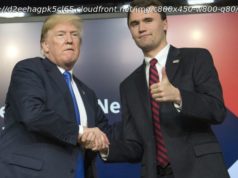 Will Donald Trump make the Cabinet great again?
Will Donald Trump make the Cabinet great again?
Recent reports suggest that once in office, the president may delegate a great deal of policymaking authority to his 15 Cabinet secretaries, rather than managing things hands on or through White House staff.
Trump is planning to give his Cabinet « unusually wide latitude, » Politico’s Josh Dawsey and Andrew Restuccia reported earlier this month, citing sources close to the transition. They added that Trump’s own role would likely be that of a « chairman-of-the-board style manager, » focusing on « high-profile issues, publicity and his brand. »
More from Vox:
The 4 most powerful people in Washington are white men again
Photos: the crowd at Donald Trump’s inauguration vs. Barack Obama’s
Hillary Clinton wore white — a symbol of women’s suffrage — to Trump’s inauguration
This would come as a contrast to the increasingly White House–dominated systems recent presidents have set up — and that secretaries have chafed at, viewing many White House staffers as overly political and power-hungry micromanagers. « Never has the job of Cabinet secretary seemed smaller, » Glenn Thrush wrote in a 2013 feature on President Obama’s team.
For a president who has little interest in the nitty-gritty of policy, this seems to make a whole lot of sense. Why not let the Cabinet secretaries — many of whom are successful businessmen or generals — run their own shops? That would bring different voices into the policymaking process rather than centralizing power in the White House yet again.
Here’s the problem: This has been tried before, several times, and it never seems to work out. « My reaction is that will last until the first few Cabinet meetings, » says Andrew Rudalevige, a political science professor at Bowdoin College.
Indeed, from Richard Nixon through Obama, nearly every new president has come into office vowing to empower his Cabinet, but eventually ended up reining them in and empowering the White House instead.
That’s because there’s a structural problem here: The president and his White House team are charged with coming up with an overall strategy for the administration’s success, but each Cabinet official tends to end up primarily concerned with his or her department’s particular set of issues. This is a recipe for conflict. For example:
Eventually, recent presidents have generally concluded that a having a Cabinet full of independent actors is more trouble than it’s worth. And while it’s not impossible for Trump to defy this historical trend, he’d have to solve some serious incentive problems — and be a strikingly good manager — to pull it off.
New presidents with little experience in the executive branch often idealistically believe they can use the Cabinet better than their predecessors, either through greater delegation or by relying on it as an advisory body.
But using the full Cabinet as an advisory body is hard in practice. For one, it’s too big these days — there are 15 full department secretaries and seven other Cabinet-level officials. More importantly, the various secretaries often have little relevant knowledge or experience about the issues their counterparts in other departments are facing. So as a rule, modern-day Cabinet meetings have been purely for show.
As a result, Cabinet secretaries end up being less attuned to the political, strategic, and messaging priorities of the White House. That’s in part simply because of where they sit and whom they see and talk to every day. It’s also in part due to their own bureaucratic incentives and self-interest.
« The reality is that Cabinet secretaries’ duties and inclinations often put them on a collision course with White House staffers, who are trying to rein them in and harness them to presidential priorities, » writes James Pfiffner , a public policy professor at George Mason University.
« Presidents making these decisions at the start of their terms are starting at the lowest point of knowledge about how bureaucracy works and how the government works, » says Matthew Dickinson, a political scientist at Middlebury College. « But then you get into the governing details, and you realize you’ve delegated authority to, say, Betsy DeVos, who’s decided to pick a fight with the teachers unions, or Rex Tillerson, who’s gone out pursuing a solution to the Mideast problem that’s contrary to what you want. »
In early 2009, President Obama was desperately trying to woo rural red-state Democratic senators, knowing he’d eventually need their votes for his health reform bill. His White House staff knew this was one of the president’s top priorities, and that other issues — like new gun control legislation — would have to take a back seat.
Attorney General Eric Holder, however, didn’t get the memo. Back during the campaign, Obama had said he’d push for renewing the expired ban on assault weapons. So when Holder was asked about the topic at the press conference, he said the administration planned to do just that. And as Daniel Klaidman recounts in his book Kill or Capture , White House Chief of Staff Rahm Emanuel was not exactly happy about it:
Emanuel was furious. He slammed his desk and cursed the attorney general. Holder was only repeating a position Obama had expressed during the campaign, but that was before the White House needed the backing of pro-gun Democrats from red states for their domestic agenda. The chief of staff sent word to Justice that Holder needed to « shut the fuck up » on guns…
The conflict between Holder and Emanuel — which recurred again and again on various topics over Obama’s first two years — is just one example of how a well-meaning Cabinet secretary can end stepping on the White House’s preferred strategy or message of the day. Thrush’s piece on the Cabinet contains a similar tale about Energy Secretary Steven Chu, who committed the awful crime of publicly discussing climate change when the administration wanted to focus on jobs.
Neither Holder nor Chu was trying to undercut the president or his positions. But the Senate math on health reform and the White House message of the day on the economy just weren’t at the forefront of their minds, since they were spending more time on their own issue areas. So they end up being viewed as troublemakers by a monomaniacally focused White House.
« If you are letting the Cabinet do what it wants, you will have lots of different stories, and it’s harder to control the narrative of your administration, » Rudalevige says. For Donald Trump in particular — who always wants to be the center of attention — he may not be so thrilled if his Cabinet secretaries keep making news that he doesn’t like.
But some Cabinet clashes with the White House have deeper roots than a simple lack of message discipline. When appointees go off to head their respective departments, many suddenly… change.
« It’s quite standard for political appointees to come in and then be exposed to the mission of the agency, and have senior staff brief them, to learn something about the agency and enlarge their perspective. And they end up moderating some of their views, » Harvard law professor and former Obama climate adviser Jody Freeman recently told Vox’s Brad Plumer.
And in the most extreme cases, these appointees become viewed as championing their department’s interests, or the interests of the constituents the department is closest to, over the president’s own priorities.
Nixon aide John Ehrlichman referred to this phenomenon as « going native. » He had a point, Rudalevige argues, writing that « presidents constantly and correctly worry that department heads have divided loyalties … [that] the secretaries may become champions of the department as an institution.






